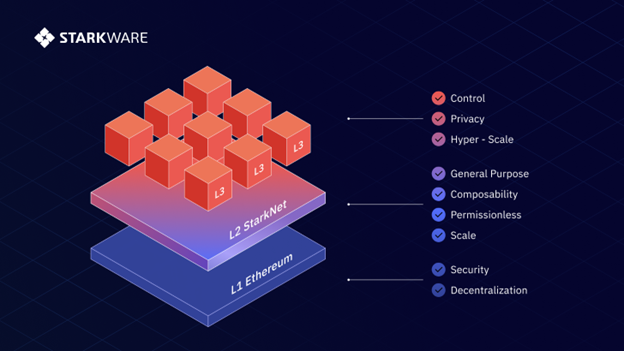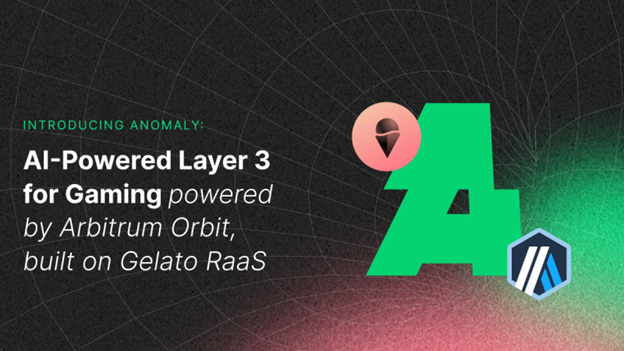 |
| By Jurica Dujmovic |
First, there were Layer-1 blockchains.
Also called a “base chain,” this is the primary blockchain for a network. Blockchains like Bitcoin (BTC, “A-”), Ethereum (ETH, “B+”) and Solana (SOL, “B”) are Layer-1s.
Then, the previous bull market saw the rise of Layer-2 blockchains, or L2s.
Built on top of Layer-1s, these “side chains” are scaling solutions designed to help increase the network’s throughput.
This includes chains like Polygon (POL, Not Yet Rated) and Arbitrum (ARB, “B-”), which are Ethereum-based L2s.
If you’ve only been following headlines, you may think that’s where blockchain development ends. But in truth, the crypto world has been quietly building Layer-3s for the past couple of years.
And now, they've reached a critical inflection point.
Just when you thought blockchain architecture couldn't get any more layered than a wedding cake, L3s have emerged to add another tier of complexity (and opportunity).
What Even Is a Layer-3, Anyway?
As Vitalik eloquently put it in his 2022 blog post, "L2 is for general-purpose scaling, L3 is for customized scaling” through specialized applications.
In other words, L2s handle the bulk work for the masses. Meanwhile, L3s provide bespoke environments for projects that need their own rules, tokens or optimizations.

So, why has this next layer emerged now?
It's all about infrastructure maturity.
The L3 concept wasn't possible until Layer-2s themselves became stable and battle-tested. And it’s only been over the past 18-24 months that major L2 ecosystems have truly matured to boast billions in total value locked (TVL) and thriving dApp landscapes.
The technical frameworks supporting L3s needed time to stabilize before anyone could reliably build on top of them.
Use Cases That Are Actually Catching Fire
L3s have emerged as the natural next step to onboard specialized applications needing web2-like performance — like on-chain gaming, social networks, AI and enterprise solutions — without sacrificing the security blanket of the Ethereum network.
But to target the most promising opportunities, we’ll need to look at what real business are utilizing L3s.
The verticals making the most noise are …
Gaming: The Front-Runner
Gaming is undoubtedly the hottest use case for L3s. Traditional blockchain gaming faces the eternal challenge of high gas fees and slow transactions — conditions unacceptable to players used to instant feedback.
L3s solves this by offering dedicated chains with high throughput, subsidized fees and game-specific logic.

The investment thesis? Gaming could bring millions of mainstream users to crypto through these custom chains. That would mean crypto could finally tap into the $200+ billion gaming industry.
DeFi: Seeking CEX-Level Performance
DeFi protocols are flocking to L3s to overcome the performance limitations — such as speed and cost — that have kept them from competing with centralized exchanges.
For investors, these DeFi L3s represent specialized financial networks, with each major exchange having its own chain optimized for its specific product.
This dramatically increases capital efficiency and allows protocols to capture fees at both the chain and protocol levels.
AI and Data Networks: The New Frontier
Perhaps the most intriguing emerging use case is at the intersection of blockchain and AI.
That’s because L3s can serve as verifiable compute layers. They can ingest large datasets, run AI algorithms and provide cryptographic proofs of computations.
This opens doors for AI model marketplaces, oracle networks and Internet of Things systems that prioritize very fast finality and custom transaction types.
For example, Chainlink (LINK, “C+”) could one day spin up an L3 for oracle updates, allowing many more data feeds at high frequency.
The Most Important L3 Frameworks
The race to become the dominant L3 framework is heating up fast. So, here are the major players you should know about:
Arbitrum’s Orbit Chains: The Early Favorite
Arbitrum has positioned Orbit as a "your chain, your rules" solution, and it's gaining serious traction.
Using the battle-tested Arbitrum Nitro stack, Orbit lets developers launch highly customizable chains with flexible settlement options. Developers can configure Orbit chains as either L2s, which can settle directly to Ethereum, or as L3s settling to another L2.
What makes this particularly interesting for investors is Arbitrum's monetization strategy. That’s because it involves a 10% profit-sharing model — 8% to the Arbitrum DAO and 2% to a developer guild.
This means ARB token holders could potentially benefit from every successful Orbit chain.
Notable L3 projects include:
- Xai: A gaming-focused L3 with its own XAI token, built specifically for high-performance gaming

- Syndr: An options/futures chain that charges low fees to traders. Syndr provides low-latency trading, enabling swift execution of trades
The first real Orbit chains only began appearing in late 2023 and early 2024. By Q1 2024, over 50 Orbit chains were in development.
We're just seeing the beginning of this proliferation.
ZKsync’s Elastic Chains
ZKsync’s (ZK, “C-”) approach to L3s involves what they initially called Hyperchains — later rebranded to "Elastic Chains" due to trademark issues. These are essentially sovereign ZK-rollups that use their own variant of zkEVM technology.
Their killer feature? Hyperbridges — native interoperability between all chains in the ecosystem. Rather than each app-chain existing on an isolated island, zkSync provides built-in protocols to connect them seamlessly.
The business model here revolves around the ZK token, which is positioned to gain utility through the ZK Gateway — a protocol used for cross-chain interactions. As more Elastic Chains launch and send messages or liquidity through shared bridges, demand for the ZK token could grow.
Standout projects include:
- Space and Time (SxT): A decentralized AI data warehouse launching its own Elastic Chain
- GRVT (Gravity): A hybrid exchange aiming for mind-boggling throughput (600k trades/sec) and sub-2 millisecond latency. However, U.S. residents are geo-blocked from accessing it.
StarkNet Appchains (SN Stack)
StarkWare's take on L3s involves the StarkNet Stack (SN Stack) to enable app-specific chains that plug into StarkNet (STRK, Not Yet Rated). These use the same STARK-based validity proofs as the main StarkNet L2.
While StarkWare hasn't explicitly mandated a profit-sharing model, as Arbitrum has, the strategy seems to be growing the value of the StarkNet ecosystem and STRK token indirectly through network effects.
Early adopters include Paradex, a decentralized perpetuals exchange building a custom rollup on SN Stack.
How to Invest
If you're looking to position yourself for the L3 revolution, consider these approaches:
-
Base Layer Tokens: You can minimize the risk involved in investing in cutting-edge, unproven tech if you invest in the project’s foundations — tokens of L1s/L2s that benefit from L3 growth, like ETH or ARB.
These will likely accrue value from their ecosystems of child networks.
- Framework Tokens: The tokens of the most successful L3 frameworks could see significant appreciation as their ecosystems grow. Arbitrum's profit-sharing model and zkSync's cross-chain utility token are particularly interesting.
- Specific Appchain Projects: Early-stage investments in promising L3 applications — especially the sectors mentioned earlier — could yield outsized returns if they capture meaningful market share.
The Challenges Ahead
It's not all rainbows and recursive proofs, though.
L3s face some serious hurdles. Namely …
-
Security and Complexity: Adding more layers can create weak links in the chain. Most early-stage L3 projects will initially have a single entity (the project team) controlling which transactions get processed and in what order.
This means users need to trust this central authority, even though the underlying blockchain math still prevents them from stealing funds. In a system with multiple security checkpoints, each one needs to be trustworthy for the whole system to work properly.
- Fragmented User Experience: Jumping between potentially hundreds of different L3s could be a UX nightmare. Account abstraction is already emerging as the key user experience glue that can make L3s invisible to users. This would let them interact seamlessly with multiple chains … without managing separate accounts or manually approving each cross-chain transaction.
- Regulatory Questions: As app-specific chains proliferate, some may fall under specific regulations. We might see a future where some L3s are fully decentralized while others operate as compliant consortium chains.
The Bottom Line
L3s represent the next logical evolution in blockchain architecture. They offer specialized applications to achieve web2-like performance without sacrificing the security and network effects of established chains.
We’re still in the early days of this emerging sector, one that could become the standard for application-specific blockchains.
Think of it as the "AWS for appchains" moment: Frameworks are being built, early adopters have jumped in and the monetization paths are emerging.
And in crypto, being ahead of the curve is where the real opportunities live.
Whether you are interested in getting direct exposure L3s …
Or want to take a more conservative approach and invest in the base layer tokens supporting their development …
This is one exciting new narrative that should be on every crypto investor’s radar.
Best,
Jurica Dujmovic

